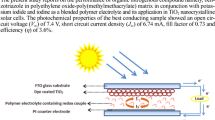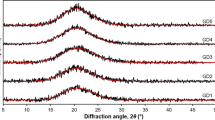Abstract
In the present study, γ-ray-irradiated and un-irradiated PVA/PPy/KI/I2 conducting polymer electrolytes have been prepared for dye-sensitized solar cell (DSSC). The conducting polymer electrolyte was prepared by solution cast technique. The degree of crystallinity of both the γ-ray-irradiated and un-irradiated samples has been studied using X-ray diffraction (XRD), and the studies show that γ-ray irradiation increases the amorphous nature. The band gap energy, Urbach’s energy, and no. of carbon in a cluster were determined from the UV–visible spectra. An electrical conductivity of all the samples has been analyzed by four-probe method, and it shows an increase in the electrical conductivity of γ-ray-irradiated samples. The EIS measurement revealed that the γ-ray-irradiated electrolyte possessed excellent electro-catalytic activity and low Rct1 at the CE/electrolyte interface. A significant improvement in the photo-conversion efficiency of γ-ray-irradiated polymer electrolyte in DSSC by 4.53% was also observed. This proves to be better and efficient DSSCs for building window glass system. Moreover, the stability tests indicated that ~ 80% of the initial efficiency was persistent after the long-term stability of 450 h.











Similar content being viewed by others
References
Renewables 2018: analysis and forecasts to 2023 (2018) IEA, Paris. https://doi.org/10.1787/re_mar-2018-en. Accessed 09 Oct 2018
Hagfeldt A, Boschloo G, Sun L, Kloo L, Pettersson H (2010) Dye-sensitized solar cells. Chem Rev 110:6595–6663
Grätzel M (2003) Dye-sensitized solar cells. J Photochem Photobiol C Photochem Rev 4:145–153
Daeneke T, Kwon TH, Holmes AB, Duffy NW, Bach U, Spiccia L (2011) High-efficiency dye-sensitized solar cells with ferrocene-based electrolytes. Nat Chem 3:211–215
Fakharuddin A, Jose R, Brown TM, Fabregat-Santiago F, Bisquert J (2014) A perspective on the production of dye-sensitized solar modules. Energy Environ Sci 7:3952–3981
Usha K, Mondal B, Sengupta D, Kumbhakar P (2015) Photo-conversion efficiency measurement of dye-sensitized solar cell using nanocrystalline TiO2 thin film as photo-anodes. Measurement 61:21–26
Ting CC, Chao WS (2010) Measuring temperature dependence of photoelectric conversion efficiency with dye-sensitized solar cells. Measurement 43:1623–1627
Jeeju PP, Varma SJ, Francis Xavier PA, Sajimol AM, Jayalekshmi S (2012) Novel polypyrrole films with excellent crystallinity and good thermal stability. Mater Chem Phys 134:803–808
Nanda P, Maity S, Pandey N, Ray R, Thakur AK, Tarafdar S (2011) Conductivity enhancement in polymer electrolytes on gamma irradiation. Radiat Phys Chem 80:22–27
Raghu S, Kilarkaje S, Sanjeev G, Nagaraja GK, Devendrappa H (2014) Effect of electron beam irradiation on polymer electrolytes: change in morphology, crystallinity, dielectric constant and AC conductivity with dose. Radiat Phys Chem 98:124–131
Nath AK, Kumar A (2015) 100 MeV Si9+ swift heavy ion irradiation induced enhancement in electrochemical properties of electrolyte membrane composites based on ionic liquid-polymer-nanocomposite. J Memb Sci 485:30–41
Zainuddin, Albinska J, Ulański P, Rosiak JM (2002) Radiation-induced degradation and crosslinking of poly (ethylene oxide) in solid state. J Radioanal Nucl Chem 253:339–344
Damle R, Kulkarni PN, Bhat SV (2009) The effect of composition, electron irradiation and quenching on ionic conductivity in a new solid polymer electrolyte: (PEG) x NH4I. Pramana 72:555–568
Manikandan KM, Yelilarasi A, Senthamaraikannan P, Saravanakumar SS, Khan A, Asiri AM (2018) The conducting polymer electrolyte based on polypyrrole-polyvinyl alcohol and its application in low-cost quasi-solid-state dye-sensitized solar cells. J Solid State Electrochem 22:3785–3797
Hema M, Tamilselvi P, Pandaram P (2017) Conductivity enhancement in SiO2 doped PVA:PVDF nanocomposite polymer electrolyte by gamma ray irradiation. Nucl Instruments Methods Phys Res Sect B Beam Interact with Mater Atoms 403:13–20
Noor MM, Buraidah MH, Careem MA, Majid SR, Arof AK (2014) An optimized poly (vinylidene fluoride-hexafluoropropylene)–NaI gel polymer electrolyte and its application in natural dye sensitized solar cells. Electrochim Acta 121:159–167
Khan A, Khan AAP, Asiri AM, Gupta V, Rathore M (2016) Preparation, properties and applications of organic–inorganic hybrid nanocomposite poly (aniline-co-o-toluidine) tungstomolybdate. J Mol Liq 216:646–653
Kesavan K, Mathew CM, Rajendran S (2014) Lithium ion conduction and ion-polymer interaction in poly (vinyl pyrrolidone) based electrolytes blended with different plasticizers. Chinese Chem Lett 25:1428–1434
Singh R, Bhattacharya B, Tomar SK, Singh V, Singh PK (2017) Electrical, optical and electrophotochemical studies on agarose based biopolymer electrolyte towards dye sensitized solar cell application. Measurement 102:214–219
Arshak A, Zleetni S, Arshak K (2002) γ-radiation sensor using optical and electrical properties of manganese phthalocyanine (MnPc) thick film. Sensors 2:174–184
Saion E, Susilawati, Doyan A, Zainal Abidin S, Azmi Z, Zulkfli A, Mohd Zaki AR, Dahlan KZH, Karni T (2005) Changes in the optical band gap and absorption edge of gamma-irradiated polymer blends. J Appl Sci 5:1825–1829
Abd El-Kader KM, Orabi AS (2002) Spectroscopic behavior of poly (vinyl alcohol) films with different molecular weights. Polym Test 21:591–595
Ahmad F, Sheha E (2013) Preparation and physical properties of (PVA)0.7(NaBr)0.3 (H3PO4)xM solid acid membrane for phosphoric acid–fuel cells. J Adv Res 4:155–161
Raja V, Sarma A, Rao VVRN (2003) Optical properties of pure and doped PMMA-CO-P4VPNO polymer films. Mater Lett 57:4678–4683
Abdel-Fattah A, Abdel-Hamid H, Radwan R (2002) Changes in the optical energy gap and ESR spectra of proton-irradiated unplasticized PVC copolymer and its possible use in radiation dosimetry. Nucl Instruments Methods Phys Res Sect B Beam Interact with Mater Atoms 196:279–285
Rai RC (2013) Analysis of the Urbach tails in absorption spectra of undoped ZnO thin films. J Appl Phys 113:153508–153505
Antar EM (2014) Effect of γ-ray on optical characteristics of dyed PVA films. J Radiat Res Appl Sci 7:129–134
Hassanien AS, Akl AA (2018) Optical characteristics of iron oxide thin films prepared by spray pyrolysis technique at different substrate temperatures. Appl Phys A 124:752–716
Fink D, Chadderton LT, Hoso F, Omichi H, Schmoldt A (1995) Depth distribution of infrared absorption of ion irradiated PETP. Radiat Eff Defect S 133:121–131
Raghu S, Archana K, Sharanappa C, Ganesh S, Devendrappa H (2015) The physical and chemical properties of gamma ray irradiated polymer electrolyte films. J Non-Cryst Solids 426:55–62
Nerkar DM, Rajwade MR, Jaware SE (2015) Preparation and electrical characterization of free standing PVA-PPy-FeCl3 composite polymer films. Arch Appl Sci Res 7:17–24
Parvatikar N, Jain S, Bhoraskar SV, Ambika Prasad MVN (2006) Spectroscopic and electrical properties of polyaniline/CeO2 composites and their application as humidity sensor. J Appl Polym Sci 102:5533–5537
Ramesh S, Ng HM, Shanti R, Ramesh K (2013) Studies on the influence of titania content on the properties of poly (vinyl chloride)-poly (acrylonitrile)-based polymer electrolytes. Polym-Plast-Technol Eng 52(14):1474–1481
Maheswari D, Venkatachalam P (2015) Enhancing the performance of dye-sensitized solar cells based on organic dye sensitized TiO2 nanoparticles/nanowires composite photoanodes with ionic liquid electrolyte. Measurement 60:146–154
Wang Q, Moser JE, Grätzel M (2005) Electrochemical impedance spectroscopic analysis of dye-sensitized solar cells. J Phys Chem B 109:14945–14953
Gong J, Qiao H, Sigdel S, Elbohy H, Adhikari N, Zhou Z, Sumathy K, Wei Q, Qiao Q (2015) Characteristics of SnO2 nanofiber/TiO2 nanoparticle composite for dye-sensitized solar cells. AIP Adv 5:067134–067110
Yue G, Wang L, Zhang X’a, Wu J, Jiang Q, Zhang W, Huang M, Lin J (2014) Fabrication of high performance multi-walled carbon nanotubes/polypyrrole counter electrode for dye-sensitized solar cells. Energy 67:460–467
Jung MH (2014) Polypyrrole/poly (vinyl alcohol-co-ethylene) quasi-solid gel electrolyte for iodine-free dye-sensitized solar cells. J Power Sources 268:557–564
Yuan S, Tang Q, He B, Yu L (2015) Conducting gel electrolytes with microporous structures for efficient quasi-solid-state dye-sensitized solar cells. J Power Sources 273:1148–1155
Xu Q, Li M, Yan P, Wei C, Fang L, Wei W, Bao H, Xu J, Xu W (2016) Polypyrrole-coated cotton fabrics prepared by electrochemical polymerization as textile counter electrode for dye-sensitized solar cells. Org Electron 29:107–113
Qin Q, Zhang R (2013) A novel conical structure of polyaniline nanotubes synthesized on ITO-PET conducting substrate by electrochemical method. Electrochim Acta 89:726–731
Arbab AA, Peerzada MH, Sahito IA, Jeong SH (2017) A complete carbon counter electrode for high performance quasi solid state dye sensitized solar cell. J Power Sources 343:412–423
Singh PK, Nagarale RK, Pandey SP, Rhee HW, Bhattacharya B (2011) Present status of solid state photo electrochemical solar cells and dye sensitized solar cells using PEO-based polymer electrolytes. Adv Nat Sci Nanosci Nanotechnol 2:023002–023015
Acknowledgments
The authors acknowledge the help rendered by Kudankulam Nuclear Power Plant (KKNPP), Tirunelveli, Tamil Nadu, India, in exposing the polymer electrolyte to γ-ray irradiation using the Gamma Auto Irradiation system. Dr. T. Dhanalakhsmi, Associate Professor, Department of Chemistry, Kamaraj College of Engineering and Technology, Virudhunagar, is gratefully acknowledged for her valuable support for the preparation of the manuscript.
Author information
Authors and Affiliations
Corresponding author
Additional information
Dedicated to the memory of Ivo Alexandre Hümmelgen
Publisher’s note
Springer Nature remains neutral with regard to jurisdictional claims in published maps and institutional affiliations.
Rights and permissions
About this article
Cite this article
Manikandan, K.M., Yelilarasi, A., Pandaram, P. et al. The effect of γ-ray-irradiated conducting polymer electrolyte and its application of dye-sensitized solar cells to building window glass system. J Solid State Electrochem 24, 251–261 (2020). https://doi.org/10.1007/s10008-019-04306-5
Received:
Revised:
Accepted:
Published:
Issue Date:
DOI: https://doi.org/10.1007/s10008-019-04306-5




